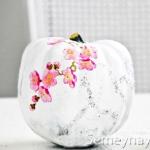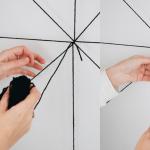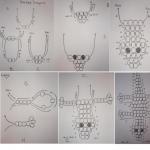Crochet pico 3 air loops. How to crochet a pico correctly
Pico (or pique) is the simplest, but at the same time very beautiful pattern that is tied different products for example, tablecloths, napkins, towels and, not usually, shoes. Products, the edges of which are tied with pico, look very beautiful and original. For crocheting this element, the patterns are given below. If you are interested in video tutorials, then scroll to the end of the article.



And here is the picot in the patterns:


But there are options for knitting pico and knitting needles.
To learn how to crochet a pico, you can check out the master class below.
Pico crochet: step by step MK for beginners
To perform a picot, you need to tie a chain of 3 air loops(vp) and connect it first with a connecting post (ss).
Consider knitting pico with single crochet (sat / n) in more detail.

According to this pattern, you need to knit 3 sat / n.

Then tie a chain of 3 VP.

Insert the hook into the s / n from which these loops were started, passing it through the loop of the top of the column and the side wall.


Grab the thread.

And knit the loops that are on the hook.

The result is a pico element. As you can see, crocheting a picot is not difficult at all.
Repeat from beginning to end the required number of times, this is what happens:

In the same way, you can knit a picot on chains from VP and above ss / n.
The pico or pique pattern has a large number of knitting options. All of them decorate very well the product tied by them, which looks much more interesting, having such a lining. And the product, for which the pique was used for knitting, looks very unusual and elegant.
Beautiful samples
Below are the piqué crochet patterns.

The following pique patterns can be used not only for strapping, but also, as in the first pattern, used in the pattern itself.







If knitting according to patterns and descriptions is difficult for you, then you can use video tutorials in which everything is shown clearly.
Video compilation to help beginners
Classic version:
Trefoil:
Reduced size:
Red and white strapping option:
Style "On poles":
Volumetric technique:
Pico, crocheted(or, as it is also called, pique) is the simplest, but at the same time, beautiful pattern for strapping products. You can tie a pico with any knitted items, incl. knitting needles, as well as napkins, tablecloths, towels and even shoes. Things with such a strapping look original and beautiful. How to crochet a pico pattern yourself? Such a loop is not difficult to knit at all. Novice craftswomen will easily learn how to perform this element if they carefully study our master class with diagrams.



Attention to the video tutorial:
Educational MK on knitting pico crochet according to patterns
Pico is a chain connected from several air loops and closed in a circle. There are several ways in which it fits.
The classic version is knitted over the main row of the product.

In order to knit the classic version, you need to insert the hook at the beginning of the canvas, dial 3 vp, return the hook to the loop where you started to knit air loops and knit. The photo below shows the diagram.

A video tutorial will help you understand this technique thoroughly.
Simple Shamrock pattern in the finished product

Insert the hook into the place where the picot will be, dial 3 vp. and close them in a ring with a connecting post. Next, knit 3 more vp. and crochet into the first c. etc., that is, at the beginning of the second leaf of the trefoil. In the same way, knit the third sheet. Connect all the leaves by tying a connecting post in the loop of the main row of the canvas. A diagram of this pattern is shown in the photo below.

Video tutorial:
"Coins" to decorate the created version

Knit 5 ch, remove the hook from the loop, stand in the first ch. of five loops, grab the left loop and knit. A rounded picot scheme is shown in the photo.

Flat pico and triangular for every taste

This type of strapping is performed when you need to create a wavy edge on the product. Cast on 5 vp, make 1 yarn over, knit from the first vp. double crochet and fix the "picot" with a connecting post after 3 loops from the beginning of the set vp.

Dial 5 VP Along this chain, starting from the second loop from the hook, knit st. b / n., 1 semi., st. s / n, st. s / 2n. It turns out a triangle. Fasten this element to the canvas with a connecting loop through 3 loops from the beginning of the chain.
Neck strapping in this technique is quick and easy.
In any knitted product you need to process the neck. The point of the strapping is to fix, seal and decorate the edge of the product. Crocheting the neck with Pico (diagrams below) is the most the best way. In the following photos you will see the products, the neck of which is framed "pico", as well as the strapping schemes.


These neck options are made with classic pico strapping from 3 vp. The description of knitting this pattern is set out in this article above.
In the next photo you can see a knitted collar, the neck of which is also decorated using this technique.

In this case, the loop is knitted on every third column. To make it more clear for knitters how the neck is tied, we give knitting patterns for the entire collar.


We create a product in lace trim in a master class
Delicate and light laces are obtained by knitting them using the above technique. In the following photos, you can consider options for lace trims and knitting patterns.

Lace in 4 interesting options
Dial a chain from vp 1 row. Art. b \ n. in each VP chains.
2 row. 3 vp lifting, 2 vp, 1 st. s / n. after 2 tbsp. b / n. prev. row, 2 vp, 1 tbsp. s / n. after 2 tbsp. b / n. prev. row. So knit to the end of the row.
3 row. * 8 Art. b / n., 10 vp, return to the beginning of the row, fasten a chain of 10 vp with a blind loop. tie (3 tbsp. b / n., picot from 3 vp, repeat 3 times), 2 tbsp. b / n., picot from 3 vp, 2 tbsp. b / n. * Repeat from * to *.
Lace No. 2.2 row. 3 vp lifting, 2 vp, 1 st. s / n. after 2 tbsp. b / n. prev. row, 2 vp, 1 tbsp. s / n., after 2 tbsp. b / n. prev. row. So knit to the end of the row.
3 row. * 9 Art. b / n., 5 vp, st. s / n. after 2 tbsp. b / n. prev. row, 5 vp, art. s / n., from one point, 5 vp, fix a chain of 5 vp with a blind loop, each arch of 5 vp. tie (3 tbsp. b / n., picot from 3 vp., 3 tbsp. b / n., repeat 3 times), 2 tbsp. b / n., picot from 3 vp, 2 tbsp. b / n. * Repeat to the end of the row.
Lace No. 3.
Dial a chain from vp 1 row. 1 tbsp. b / n. in each VP chains.
2 row. 3 vp lifting, 5 vp, 1 st. s / n., after 5 tbsp. b / n. prev. row. So knit to the end of the row.
3 row. All Art. b / n.
4 row. * Art. b / n., 1 vp. lifting, st. b / n., 1 vp, 2 st. s / n., 1 vp, 2 st. b / n., 1 vp, 2 st. s / n.,
1 vp, 1 st. b / n., 1 vp, 2 st. s / n., 1 vp, 1 st. b / n., 12 vp, fix with a blind loop for vp. prev. rows, tie (3 st. b / n., picot from 3 vp, repeat 4 times), st. b / n., 1 vp,
2 tbsp. s / n. * Repeat to the end of the row.
Lace No. 4.
Dial a chain from vp 1 row. 1 tbsp. b / n. in each VP chains.
2 row. 3 vp lifting, 2 vp, 1 st. s / n., after 2 tbsp. b / n. prev. row, 2 vp, 1 tbsp. s / n., after 2 tbsp. b / n. prev. row. So knit to the end of the row.
let's consider one little trick that is quite common in crocheting (in any strapping)
This technique is called "PIKO" and it is not difficult to knit at all.
HOW TO KNIT PIKO HOOK
Suppose we need to tie the edge of the product using a pico column of three in every third column. So, we knit three tbsp. b / n, we make three air loops ... Then we insert the hook into the same column from which these air loops were knitted, from top to bottom, grabbing the wall of the column, (3 loops on the hook) grab the working thread ....  And we pull it through all the loops at once (three loops on the hook). It turns out a kind of tubercle. So it is called "PIKO"
And we pull it through all the loops at once (three loops on the hook). It turns out a kind of tubercle. So it is called "PIKO"  Let's say it again…. again we knit 3 tbsp. b / n, 3 vp,
Let's say it again…. again we knit 3 tbsp. b / n, 3 vp,  insert the hook ON TOP into the same column from which the air chain "grows"))), grab the working thread and pull it through everything on the hook.
insert the hook ON TOP into the same column from which the air chain "grows"))), grab the working thread and pull it through everything on the hook. So we continue to the end of the row
So we continue to the end of the row Usually in "pico" 3 air loops are used, but options are also possible ... For example, "pico" from 5 vp. - the method of action remains the same only instead of a chain of 3 vp. we knit a chain of 5 vp. Also between "PIKO" there can be different amount columns, depending on the pattern.
Usually in "pico" 3 air loops are used, but options are also possible ... For example, "pico" from 5 vp. - the method of action remains the same only instead of a chain of 3 vp. we knit a chain of 5 vp. Also between "PIKO" there can be different amount columns, depending on the pattern.
And don't forget to leave your comment. Your opinion is important to me!
If you liked the article, then share this information with your friends by clicking the social media buttons! Only, a huge request! - do not copy the entire material, please use the social buttons! Do not be shy! I will help you as much as I can :) I got an idea - Share it! If you find errors - write, we will fix it! There was a desire to somehow help the blog - I will only be glad! Hosting costs money, and the materials are not cheap these days ... So, if possible, help financially)))
Pico
Tambour work very often ends in small teeth called pico. They are: dense, from air loops and lace.
The dense pico is subdivided into small, large, sharp and pico with round leaves.
Small round picot.
They are made both on the knitting itself and separately from it.
Separately, they are knitted like this: 3 air loops; Turn the work over and, seizing in the 2nd and 1st loops, knit 1 column without a cape.
On the vestibule row, this pico is performed as follows: 1 column without a cape, * 3 air loops, return and tie 2 of them without a cape; leave 1 loop and tie 1 column without a cape, grabbing into the next loop. Start from *.
Large round pico.
Cast on 5 air loops, skip 3 loops of them and tie 1 column on the 2nd loop and 1 column on the 1st loop, then repeat from the beginning.
In the event that this picot needs to decorate some tambour work, then they knit like this: tie 5 air loops, skip 3 of them and tie on the last two 2 columns; then leave 2 loops at the bottom at work and tie in the 3rd 1 column without a cape. Repeat knitting.
Sharp pico.
Throw on 6 air loops; then skip the 6th loop and knit on five stitches: 1 tight loop, 1 stitch without a cape, 1 half stitch, 1 simple stitch and finally
1 double column. Then repeat from the beginning.
Pico in small leaves.
Knitting is performed as follows: * 4 air loops; 3 simple columns in the first loop; 1 tight loop in the same loop in which 3 columns are tied **; 2 or 3 chain stitches and repeat from * to **.
If these pico form a chain-link knitting board, then instead of air loops that form a gap, they knit
2 tight loops in two loops of the previous row.
Pico in large leaves.
Performed on six air loops. In the first of them, knit 3 double stitches (the stitches of the stitches remain on the hook). Place the thread on the hook and thread it through the 4 loops. Cast on 5 stitches. Knit 1 tight loop in the loop in which the posts are connected. Repeat from the beginning.
Pico from air loops.
For small pico from air loops you need to knit: 5 air loops; 1 tight loop in the first of 5 chain stitches.
For large pico from air loops: 5 air loops; 1 column in the first of them.
Postal picot.
Connect 5 chain stitches, 1 zip post in a circle and join with the 5th chain loop.
Round picot down.
This pico is done on five air loops. Remove the hook from the loop and grab it in 1 of the five air loops. Then take the left loop and thread it through the loop on the hook.

Lacy picot.
In order to make a lace picot from air loops, you need to knit 2 air loops and pass the hook through the first air loop. Throw a thread, thread it, lower the picot from the hook. Knit 2 chain stitches again. Thread the hook again through the 1st air loop, throw on a thread, thread it, and again lower the picot from the hook. Repeat all steps from the beginning.

Lace picot with columns without a cape: 1 column without a cape; 1 air loop; pull out the loop in the size of a picot and remove the hook.
The loop can be put on a stick or a thick knitting needle (for convenience), crocheted in a horizontal thread last loop, throw a thread, thread it through this loop; 1 column without a cape, capturing in the next loop; then all over again.

Pico with a border of columns.
Take 7 chain stitches. Then follow: 1 tight loop in the 4th chain loop; 1 triple column in the 1st of seven air loops; * 1 peak of 4 air loops; 1 triple column into the 2nd cape of the first triple column and repeat from *. 
A detail such as pico, when creating crocheted clothes, is quite often used in finishing the edge of products, and is also used when performing various fancy patterns and laces. There are many different ways to knit this element. They differ among themselves both in size and shape, and, of course, in the way they are performed.
The most common option is classical method crochet pico. Here you do not need to have special skills, everything is quite simple, even a novice needlewoman can handle it.
The classic pico method
So, most often crochet pico is knitted in combination with single crochet. For example, we do edge trim knitted skirt and tie it with single crochets. But some single crochet stitches look pretty boring. Therefore, to add a little variety, we knit this decorative element. This is done, for example, every 5 single crochet. Having knitted the fifth column, we knit five loops of the chain and connect them into a ring with the help of fastening in the same loop from which we started knitting the air loops. It turns out, as it were vicious circle in the form of a droplet. Then you can continue knitting the next five single crochet. We continue the alternation until we finish tying the entire edge of the product.
You can choose the size of the pico yourself. If you need a larger version, then dial a larger number of chain stitches, if less, then the number of stitches in the chain will be less.
Knitting methods for such classic version differ only in the place of attachment connecting post... This can be the loop of the previous row, from which knitting of air loops began, or the initial loop of the chain.
Pico shamrock
There is one more original version crochet pico. It looks very nice. Knits as follows. The knitting pattern is similar to the one used in the first version, but there are still differences. We knit the first part of the element as described above. Next, we again make a chain of loops and connect it into a ring. You need to tie 3 rings, and you get the so-called trefoil. Next, we continue to knit our single crochet.
Using this method, you can decorate both an openwork tablecloth and an edge. knitted blouse... In both cases, the decor looks appropriate and original.

Pico "coin"
This option differs from the previous ones in its volume and is suitable for tying warm products made both with knitting needles and crocheted. It is quite simple to make it. Let's take a look at how pico crochets with this method. The method of execution is as follows: we knit three air loops, and then a double crochet in the initial loop of the chain. Next, you need to tie the double crochet again, and again in the first loop. After that, we again knit three loops of the chain and fasten the finished element with the help of a connecting post into the loop of the previous row, from which we started knitting the chain. Thus, you should get a kind of small circle that looks like a coin. Hence the name of this element.
Flat and triangular pico crochet
If you need to get the edge of the product that resembles a wavy line, then the flat picot option is suitable for you. It is also knitted quite simply, but single crochets are no longer used here for alternation. Just cast on five stitches of the chain and make a double crochet into the initial chain stitch. After that, we fix the finished picot using a connecting post, skipping three columns in the previous row, and repeat the required number of times.

If you want to get the edge of the product with sharp corners, then you need to learn how to knit a picot in the form of a triangle. To do this, we collect five loops of the chain and, passing the last one, we knit into each of them in order: in the fourth - a single crochet, in the next in order - a half-crochet, then - a double crochet, in the initial - a column made with two crochets. You will end up with a small triangle. We fix it to the edge of the product using a connecting post, skipping three loops in the previous row.
Now you know crochet pico, and you can try different variations of it when creating knitted clothes.





